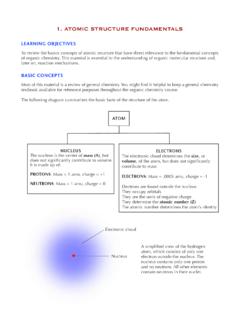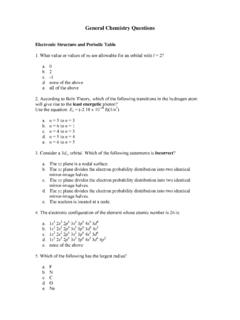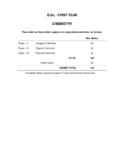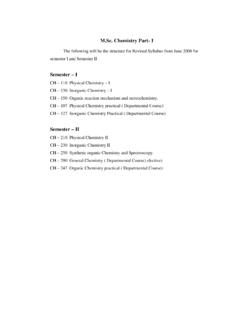Transcription of Calculation of molecular lipophilicity: State-of-the …
1 Calculation of molecular lipophilicity : State-of-the -Artand Comparison of LogPMethods on More Than96,000 CompoundsRAIMUND MANNHOLD,1 GENNADIY I. PODA,2 CLAUDE OSTERMANN,3 IGOR V. TETKO4,51 molecular Drug Research Group, Heinrich-Heine-Universita t, Universita tsstra e 1, D-40225 Du sseldorf, Germany2 Pfizer Global R & D, 700 Chesterfield Parkway West, Mail Zone BB2C, Chesterfield, Missouri 630173 Nycomed GmbH, Byk-Gulden-Str. 2, D-78467 Konstanz, Germany4 Helmholtz Zentrum Mu nchen German Research Center for Environmental Health (GmbH),Institute of Bioinformatics and Systems Biology Ingolsta dter Landstra e 1, Neuherberg D-85764, Germany5 Institute of Bioorganic & Petrochemistry, Ukrainian National Academy of Sciences, UA-02660 Kyiv, UkraineReceived 12 June 2007; revised 2 June 2008; accepted 4 June 2008 Published online 6 August 2008 in Wiley InterScience ( ).
2 DOI :We first review the State-of-the -art in development of logPpredictionapproaches falling in two major categories: substructure-based and property-basedmethods. Then, we compare the predictive power of representative methods for onepublic (N 266) and twoin housedatasets from Nycomed (N 882) and Pfizer(N 95809). A total of 30 and 18 methods were tested for public and industrial datasets,respectively. Accuracy of models declined with the number of nonhydrogen atoms. TheArithmetic Average Model (AAM), which predicts the same value (the arithmetic mean)for all compounds, was used as a baseline model for comparison.
3 Methods withRootMean Squared Error(RMSE) greater thanRMSE produced by the AAM were consideredas unacceptable. The majority of analyzed methods produced reasonable results for thepublic dataset but only seven methods were successful on the bothin housedatasets. Weproposed a simple equation based on the number of carbon atoms, NC, and the number ofhetero atoms, NHET: logP ( ) ( ) NC ( ) NHET. Thisequation outperformed a large number of programs benchmarked in this study. Factorsinfluencing the accuracy of logPpredictions were elucidated and discussed. 2008 Wiley-Liss, Inc. and the American Pharmacists Association J Pharm Sci 98:861 893, 2009 Keywords: lipophilicity ; log P Calculation ; substructure-based approaches; fragmen-tal methods; atom-based methods; property-based approaches; methods based on 3D-structure representation; empirical approaches; quantum chemical semi-empiricalcalculations; continuum solvation models; molecular dynamics calculations; molecularlipophilicity potential; lattice energy calculations; topological descriptors; graphmolecular connectivity; electrotopological-state (E-state) descriptors.
4 Consensus modelINTRODUCTIONL ipophilicity is an important parameter moni-tored by medicinal chemists in drug discovery ondaily basis. Optimal lipophilicity range along withlow molecular weight and low polar surface area isthe major driving force that leads to goodCorrespondence to: Igor V. Tetko (Telephone: 49-89-3187-3575; Fax: 49-89-3187-3585; E-mail: of Pharmaceutical Sciences, Vol. 98, 861 893 (2009) 2008 Wiley-Liss, Inc. and the American Pharmacists AssociationJOURNAL OF PHARMACEUTICAL SCIENCES, VOL. 98, NO. 3, MARCH 2009861absorption of chemicals in the intestine by passivediffusion.)
5 lipophilicity plays a main role ingoverning kinetic and dynamic aspects of 20 Hansch et in detail the impactof lipophilicity on pharmacodynamic , many reviews document the primeimportance of logPin predicting ADMET ,4 8,10,11,13 22 The common quantitative descriptor of lipophi-licity, the octanol water partition coefficientP,isdefined as the ratio of the concentrations of aneutral compound in organic and aqueous phasesof a two-compartment system under equilibriumconditions. It is mostly used in its logarithmicform, logP. Experimental procedures to measurelogPare described in details in Ref.
6 Extent of existing experimental logPdata isnegligible compared to the enormous number ofcompounds for which such data are needed. Thus,methods deriving logPfrom molecular structureare highly desired. Thefirst published method forcalculating logPfrom structure was based on a substitution procedure and was developed withsubstituentp-constants for aromatic rings method was limited to deriving anew logPfrom a parent structure whose logPwas already known. Rekker and his colleagues25 28were thefirst to publish a novel and moregeneral procedure assigning fragmental constantsto structural moieties.
7 Current methods forcalculating logPare either substructure- 33In this article, we describe the methodologicalbackground of the State-of-the -art methods andcompare their predictive power for one publicand twoin housedatasets of different size METHODSS ubstructure-based methods (Tab. 1) cut mole-cules into fragments (fragmental methods) ordown to the single-atom level (atom-based meth-ods); summing the substructure contributionsgives thefinal MethodsFragmental methods (Tab. 1) cut molecules downinto fragments and apply correction factors inorder to compensate for intramolecular interac-tions.
8 Fragmental methods work according to thegeneral formula given in Eq. (1). Thefirst termconsiders the contribution of fragment constants,fi, and the incidence of this fragment,ai, in thequery structure; the second term considers thecontribution of the correction factor,Fj, and itsTable MethodsFragmental MethodsAtom-Based MethodsReductionist approachesOriginal Ghose Crippen (ALOGP)KLOGPMOLCAD, TSAR, PrologP, DragonKowWINR evised Ghose Crippen (ALOGP98)Constructionist approachesAccelrys Discovery studio, Pipeline PilotCLOGPO sirisPACD/logPAtom types and correction factorsHierarchical clusteringXLOGP2, XLOGP3AB/LogPFragmental methods:Sf, KLOGP, and KowWIN arereductionisticapproaches; that is, fragmentand correction factor coefficients are derived by multiple regression of experimental data.
9 Fragmentvalues and interaction factors are identified and evaluated concurrently. CLOGP and ACD/logP areconstructionisticapproaches. The basic fragment values are derived from measured logPdata ofsimple molecules, then the remaining fragment set is constructed. These methods systematicallyinterpret and generalize all the possible increments. AB/LogP combines the advantages of bothreductionisticandconstructionistic approachesby using hierarchical cluster methods split molecules into single atoms and commonly do not apply correctionrules. This holds for all Ghose Crippen based methods. MOLCAD, TSAR, PrologP and Dragonimplementations are based on the original approach.
10 ALOGP98 is based on a refined is the only atom-additive method that applies OF PHARMACEUTICAL SCIENCES, VOL. 98, NO. 3, MARCH 2009 DOI ET ,bj:logP Xni 1aifi Xmj 1bjFj(1)Defining fragments larger than single atomsguarantees, that significant electronic interac-tions are comprised within one fragment; this is aprime advantage of using fragments. Arbitraryfragmentations and missing fragments that pre-vent Calculation are the main s group developed thefirst 28 Experimental logPof simple organ-ics were used to derive fragmental values by Free Wilson analyses. The development of theSf-system comprised three main period resulted in a Calculation systembased on 126 fragment values.






